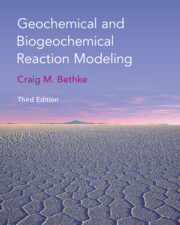Book contents
- Frontmatter
- Dedication
- Contents
- Preface
- Preface to Second Edition
- Preface to First Edition
- A Note About Software
- 1 Introduction
- 2 Modeling Overview
- PART I EQUILIBRIUM IN NATURAL WATERS
- PART II REACTION PROCESSES
- 14 Mass Transfer
- 15 Polythermal, Fixed, and Sliding Paths
- 16 Geochemical Buffers
- 17 Kinetics of Dissolution and Precipitation
- 18 Redox Kinetics
- 19 Microbial Kinetics
- 20 Association and Dissociation Kinetics
- 21 Kinetics of Gas Transfer
- 22 Stable Isotopes
- 23 Transport in Flowing Groundwater
- 24 Reactive Transport
- 25 Stagnant Zones
- PART III APPLIED REACTION MODELING
- Appendix A Sources of Modeling Software
- Appendix B Evaluating the HMW Activity Model
- Appendix C Minerals in the LLNL Database
- Appendix D Nonlinear Rate Laws
- References
- Index
18 - Redox Kinetics
from PART II - REACTION PROCESSES
Published online by Cambridge University Press: 09 December 2021
- Frontmatter
- Dedication
- Contents
- Preface
- Preface to Second Edition
- Preface to First Edition
- A Note About Software
- 1 Introduction
- 2 Modeling Overview
- PART I EQUILIBRIUM IN NATURAL WATERS
- PART II REACTION PROCESSES
- 14 Mass Transfer
- 15 Polythermal, Fixed, and Sliding Paths
- 16 Geochemical Buffers
- 17 Kinetics of Dissolution and Precipitation
- 18 Redox Kinetics
- 19 Microbial Kinetics
- 20 Association and Dissociation Kinetics
- 21 Kinetics of Gas Transfer
- 22 Stable Isotopes
- 23 Transport in Flowing Groundwater
- 24 Reactive Transport
- 25 Stagnant Zones
- PART III APPLIED REACTION MODELING
- Appendix A Sources of Modeling Software
- Appendix B Evaluating the HMW Activity Model
- Appendix C Minerals in the LLNL Database
- Appendix D Nonlinear Rate Laws
- References
- Index
Summary
Natural waters near Earth’s surface commonly exist far from redox equilibrium and hence hold a thermodynamic drive for the oxidation of some aqueous species at the expense of others, which are reduced. The rates at which such oxidation and reduction reactions occur in the natural environment are described by kinetic laws, which may account for heterogeneous catalysis or promotion by enzymes. This chapter shows how to incorporate redox kinetics into multicomponent chemical reaction models and gives a fully worked example of how such models can be applied.
Keywords
- Type
- Chapter
- Information
- Geochemical and Biogeochemical Reaction Modeling , pp. 223 - 232Publisher: Cambridge University PressPrint publication year: 2022

